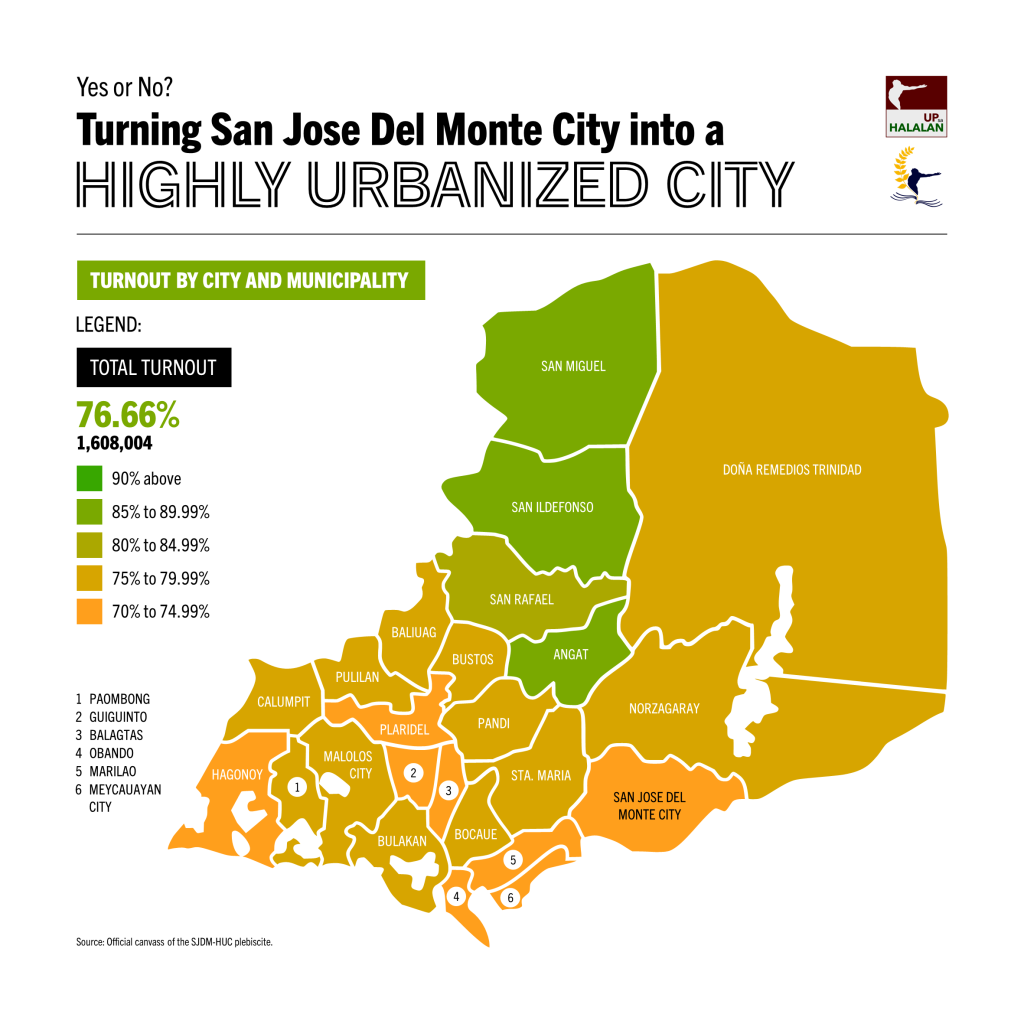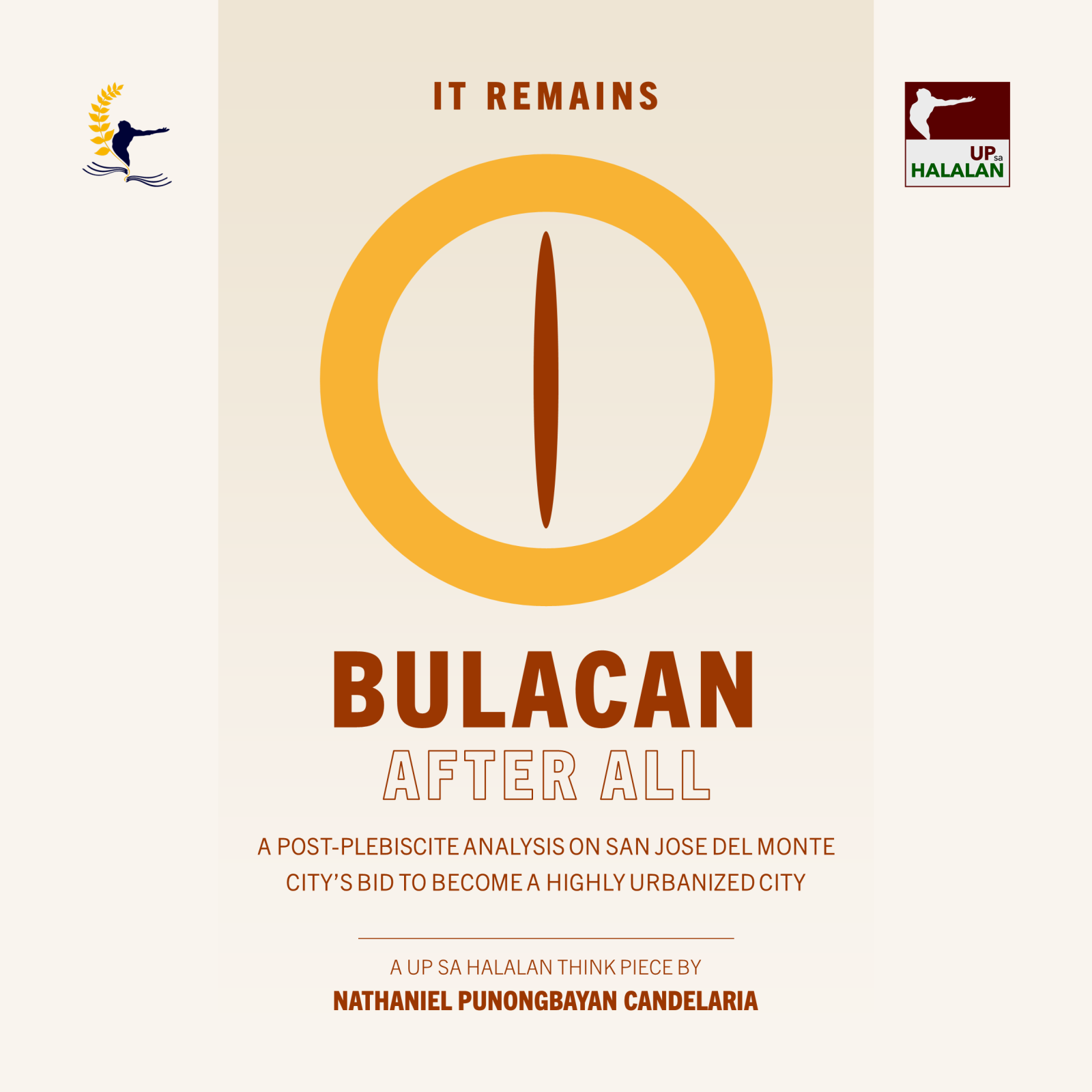The Bulacan plebiscite experience offers lessons for future plebiscites related to the creation or reclassification of LGUs in the Philippines.

On October 30, 2023, registered voters in the Province of Bulacan (such as myself) participated in a plebiscite that coincided with the Barangay and Sangguniang Kabataan Elections (BSKE), to determine the fate of the City of San Jose del Monte’s bid of becoming the country’s 34th highly urbanized city.
A highly urbanized city (HUC) is defined by the 1991 Local Government Code, under section 452, as “cities with minimum population of two hundred thousand (200,000) inhabitants, as certified by the National Statistics Office, and with the latest annual income of at least Fifty Million Pesos (Php50,000,000.00) based on 1991 constant prices, as certified by the city treasurer, shall be classified as highly urbanized cities.” If a city is classified as an HUC, section 29 of the 1991 Local Government Code states that HUCs “shall be independent of the province.”
Once ratified, the Provincial Government of Bulacan will no longer have jurisdiction over the City of San Jose del Monte. This also means that there will be a reduction in the land area and population of the province, adversely impacting on its national tax allocation as a province. Based on the criteria set under section 452 of the 1991 Local Government Code, the City of San Jose del Monte met the minimum requirements for its bid to become an HUC since it has a population of 649,918 in 2020, and had an income of PhP 684.97 million in 2022.
The city’s bid to become an HUC began with Proclamation no. 1057, which was signed by then President Rodrigo Roa Duterte on December 4, 2020, based on the city government’s request for it to become an HUC through the Sangguniang Panlungsod Resolution 2019-059-09. The President’s proclamation also stated that the bid to become an HUC must undergo a ratification through a plebiscite.
The Commission on Elections (COMELEC), through Resolution no. 23-0198, dated March 29, 2023, hereby approved the conduct of a plebiscite regarding the status of the City of San Jose del Monte on the same day as the BSKE. In terms of the execution of the plebiscite, COMELEC Resolution 10948 mandated the “holding of Barangay Assemblies” for information sharing purposes during the BSKE campaign period, and COMELEC Resolution 10949 specified the rules regarding the conduct of the plebiscite in the Province of Bulacan.
The plebiscite regarding the city’s bid of becoming an HUC was described by Dwight de Leon of Rappler as a polarizing issue among the electorate. The presence of parties both for and against the city’s bid to become an HUC were present province-wide.
The campaign for the recognition of the City of San Jose del Monte as the country’s 34th HUC in the plebiscite was spearheaded by the City Mayor, Arthur Robes and his wife, the city’s representative to the Philippine House of Representatives, Florida Robes. The Yes to HUC camp argued that the successful bid will bring more opportunities to the city, and it will also free up resources from the Province of Bulacan. The city’s bid to become an HUC was supported by the six district representatives of the province, the Mayors’ League of the Philippines Bulacan Chapter, the Vice Mayors’ League of the Philippines Bulacan Chapter, and the National Movement of Young Legislators Bulacan Chapter. A Facebook Page was also created to campaign and to argue for the city’s conversion to an HUC.

Meanwhile, the move to declare the city as an HUC was opposed by civic organizations, as well as different politicians in Bulacan. Those who oppose the city’s bid to become an HUC argued that there will be higher taxes in the city, that the city is still ill-equipped for it to survive on its own, and that the city will lose all services provided by the provincial government. The No to HUC camp has several Facebook pages, as well as a website, to show their opposition against the bid of the city. As for Bulacan politicians, the current Bulacan governor, Daniel Fernando, expressed his sentiments against the bid, while also acknowledging the right of the people to decide on this matter.
The city’s move to become an HUC was also opposed by former Bulacan governors Wilhelmino Sy-Alvarado and Roberto Pagdanganan. Apart from current and former provincial officials, another city official from the City of San Jose del Monte as well as the Bulacan Chapter of the Liga ng mga Barangay (League of Barangays) have also opposed the move.
Despite the hard-fought campaign of both camps, which were mostly done online but with limited campaigns on the ground by the Yes to HUC camp, the “No” votes prevailed in the Province of Bulacan, with a total of 820,385 “No” votes (51%), as compared to 620,707 “Yes” votes (39%), and 166,912 invalid votes (10%). Most of the towns and cities in Bulacan voted no, including residents of the City of San Jose del Monte themselves, with the exception of the City of Meycauayan, and the town of Marilao.
As a registered voter in one of the towns of the Province of Bulacan, and as a student of politics, I would like to share some insights regarding the conduct of the plebiscite in Bulacan, even if its conduct is generally peaceful and orderly.
Firstly, while views about the San Jose del Monte plebiscite on social media were polarizing, however, they were limited in their reach. One must make a conscious effort to actively search for information on social media platforms, such as Facebook and X (formerly known as Twitter), for people to be even aware of the issues regarding the plebiscite.
Due to limited posts available, there seemed to be a lack of awareness about the October 30 plebiscite in Bulacan. While only few, some social media posts that I saw, especially when I typed “Bulacan plebiscite” on the Facebook and X search bars, share this observation as well.

And secondly, even if the COMELEC mandated barangays to conduct awareness campaigns regarding the plebiscite in Bulacan, limited awareness campaigns were conducted since most, if not all barangay captains are also running for reelection. Article VI, Section 47 of the Omnibus Election Code states that either barangay captains not running for reelection, or anyone mandated by the COMELEC, are the only ones who can convene these assemblies for awareness campaign purposes. Based on my observation, only Facebook posts as well as streamers on major throughways were seen. Not all official COMELEC Facebook pages in Bulacan have shared information about the barangay assemblies to discuss the plebiscite.
Due to lack of information province-wide, this prevented the electorate from making a more informed or conscious decision. This also prevented some people that I witnessed personally from voting in the plebiscite, even if civil society organizations such as student organizations, as well as a religious organization, have already voiced out their respective positions regarding the plebiscite.
The City of San Jose del Monte plebiscite, despite the polarizing views, is generally peaceful and orderly as voters were able to cast their votes. Despite the process being peaceful and orderly, however, there are some concerns such as the lack of awareness regarding the plebiscite – both online and offline – that I observed regarding the Bulacan plebiscite that require a serious examination of different authorities.
The Bulacan plebiscite experience should lead to a careful assessment of the concerns identified and serve as lessons for future plebiscites related to the creation or reclassification of local government units (LGUs) in the Philippines.
Nathaniel Punongbayan Candelaria is Assistant Professor of Political Science, College of Social Sciences and Philosophy, University of the Philippines Diliman.
